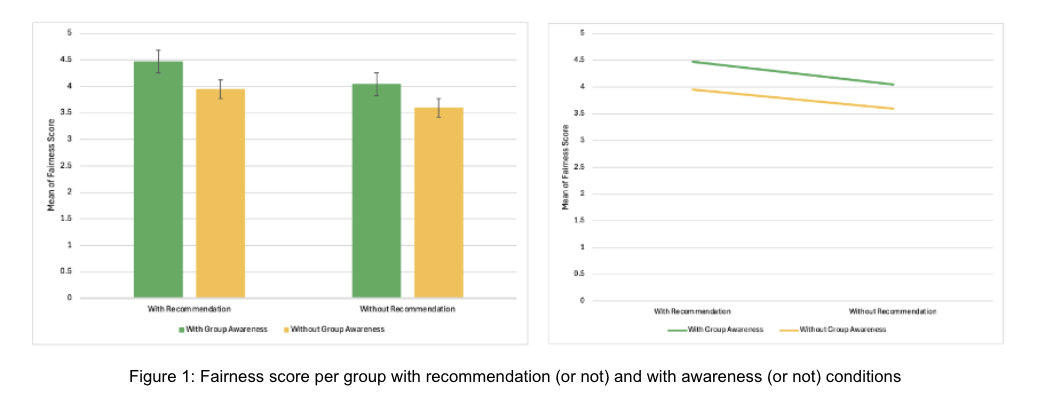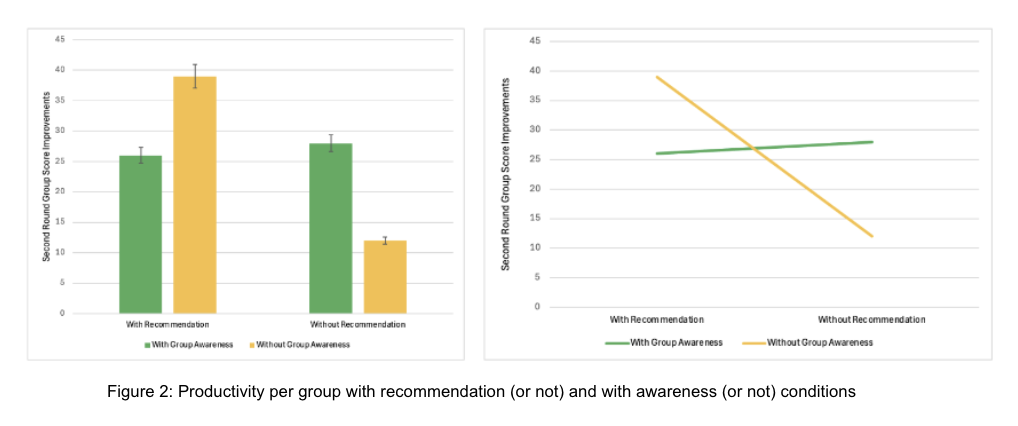Fair Workload Division Dashboard
Data analysis: As we want to understand whether independent factors “with or without system recommendation” or “with or without group awareness” can affect dependent variables as “fairness perception” or “productivity” in the workload division process, we applied mix model ANOVAs to account for possible local interdependency between data points caused by repeated measures in our user study design. Two linear mixed models (figure 1 and 2 respectively) were created regarding groups' “fairness perception” and “productivity” scores. Within the two linear models, fairness perception, which the score is derived from fairness survey such that individuals all have different score, we set individuals as a random variable nested within group, with group is also set as a random variable. System recommendation, group awareness are included as fix effects in the model. Whereas, for productivity, which the score is calculated from group score improvements between the two rounds of game, and with 3 group members sharing the same score, we set group as a random variable, while system recommendation and group awareness are still fix effects. By using fairness score as the dependent variable of a linear mixed model, there is a main effect of system recommendation as well as group awareness on fairness score. From figure 1, we can see that with recommendation conditions have higher scores than without recommendation conditions, F[1, 18]=10.81, p < 0.001, and with awareness conditions have higher score than without awareness conditions, F[1, 58]=26.29, p < 0.001. In condition where there are both recommendation and awareness, the fairness score is the highest. In contrast, without recommendation and without awareness has the lowest score. In conditions where any one of the factor is missing, there is no significant difference. The result shows that recommendation and awareness should be combined, and both of them are important factors of affecting one's fairness perception.
 We set group's productivity as the dependent variable of a linear mixed model. Contrary to fairness score relations, we can see from figure 2 that there is an interaction effect, F[1,18.1]=4.07, p=0.059. With recommendation and without awareness has the highest score, and without recommendation and without awareness has the lowest score. With or without awareness does not have significant difference in relation to productivity, F[1,17.8]=0.006, p=n.s., while with or without recommendation has significant difference F[1,17.8]=2.55, p<0.05. The result shows that recommendation matters for productivity when there is no awareness; however, if group have awareness, with or without recommendation does not have too much impact on group's productivity. Compared with figure 1, we realize that although with recommendation and with awareness has the highest fairness score, it does not necessarily result in the highest productivity score. It is with recommendation and without group awareness that has the highest productivity score. Recommendation and awareness factors can be manipulated for different purposes.
We set group's productivity as the dependent variable of a linear mixed model. Contrary to fairness score relations, we can see from figure 2 that there is an interaction effect, F[1,18.1]=4.07, p=0.059. With recommendation and without awareness has the highest score, and without recommendation and without awareness has the lowest score. With or without awareness does not have significant difference in relation to productivity, F[1,17.8]=0.006, p=n.s., while with or without recommendation has significant difference F[1,17.8]=2.55, p<0.05. The result shows that recommendation matters for productivity when there is no awareness; however, if group have awareness, with or without recommendation does not have too much impact on group's productivity. Compared with figure 1, we realize that although with recommendation and with awareness has the highest fairness score, it does not necessarily result in the highest productivity score. It is with recommendation and without group awareness that has the highest productivity score. Recommendation and awareness factors can be manipulated for different purposes. 
